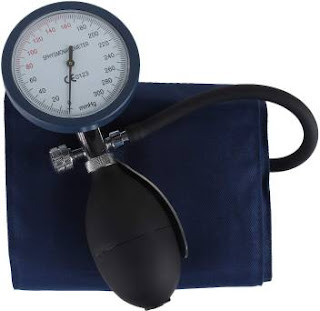Blood pressure
Blood pressure
Blood pressure is the pressure exerted by the blood on the wall of blood vessels in which it is present.
Types
Blood pressure is of two types :
1. Systolic blood pressure
2. Diastolic blood pressure
Systolic blood pressure-
It is the pressure exerted by the blood on the wall of blood vessels during the period of maximum ventricular systolic contraction. In a normal resting adult man , it is about 120 mmHg .
Diastolic blood pressure-
It is the pressure exerted by the blood on the wall of blood vessels during the period of maximum ventricular diastolic relaxation. In a normal resting adult man, it is about 80 mm HG.
Measurement.-
Nowadays, the blood pressure is measured with the help of an instrument called sphygmomanometer . In This, the blood pressure is measured in terms of air pressure when it becomes equal to blood pressure.changes in sound of blood flow is detected with the help of stethoscope whose receiver is placed over the brachial artery just below the elbow joint. The systolic pressure is recorded when first time tap -like sound is heart,while diastolic pressure is recorded when the loud sound starts muffling.
An instrument for measuring blood pressure,typically consisting of an inflatable relbber cuff which is applied to the arm and connected to a column of mercury next toa graduated scale, enabling the determination of systolic and diastolic blood pressure by increasing and gradually releasing the pressure in the cuff.
1 Bladder-
This is an inflatable bag that is used to compress.the arm to occlude the artery.to ensure full arterial compression,bladders must have specific sizing parameters.
2 Cuff-
This is designed to hold the bladder around the arm during the measurement.the cuff must be designed proprly with respect to placement and the position..
This is a device used to measure the air pressure in mmHg the manometer used in an aneroid sphygmomanometer consist of a watch-like movement to measure the air pressure applied to the cuff.to expand the diagrams , the gauge has a series of copper or beryllium and there are gears to convert the linear movement of the diaphragm to get the readings in mmHg.
This used as a deflation valve to control the cuff .this plays a vital role in getting an accurate measurement.
This is used to pump the air into
The cuff.
Types of sphygmomanometer
The three major types of sphygmomanometer
1). Mercury sphygmomanometer-
it is the most conventional form of blood pressure apparatus and is considered to be the golden standard . It consists of manually inflatable cuffs that are attached to the mercury - infused tubes.
In order to get the correct reading, the instrument should be kept on a flat surface and in an upright position. If the instrument is dropped accidentaly, there are high chances of risks. The advantage of this sphygmomanometer is that they can last of lifetime,easy to use and there is no need for recalibration due to its toxic contents, it is banned in some countries.
2). Aneroid sphygmomanometer-
Aneroid means "without fluid" and in this instrument,there is no use of mercury.it consists of a stethoscope that is attached to the cuff which is further attached to a dial gauge with tubing to convert the cuff pressure to gauge pressure, the gauge head has a mechanical part. The instrument needs to be recalibrated to avoid faulsh readings .
There are another different types of aneroid sphygmomanometer depending upon their use,and they are:
-- pocket- aneroid sphygmomanometer.
-. Palm aneroid sphygmomanometer.
It is the most technologically advanced sphygmomanometer.it is consistent of an electronic sensor to measure the blood pressure and the readings are displayed on the digital monitor, in order to measure the blood pressure, the instrument measure the fluctuations of arteries. These need to be checked using a mercury sphygmomanometer to avoid inaccurate readings.
1 Hypertension.
It is an abnormal condition characterized by persistent high blood pressure , eg; 150/90 mm.Hg main causes of hypertension are: overeating, obesity, physical and emotional stress, intake of cholesterol- rich diet, smoking, arteriosclerosis ( thickening and hardening of wall of blood vessels),. Vaso- construction and increase in peripheral resistance to blood flow. Hypertension is commonly called silent killer. It may caused rupturing of blood vessels called haemorrhage which may cause brain disease stroke if carotid artery ( which supplies blood to brain) is ruptured; or heart attack if coronary artery ( which supplies blood to heart) is ruptured.
2 Hypotension-
It is characterized by persistent low blood pressure eg; 100/50. mm HG. Main causes of hypotension are: dilation of blood vessels; rupturing of blood vessels and excessive blood loss; failure of pumping action of heart ; etc. It leads to fainting.





















Comments
Post a Comment